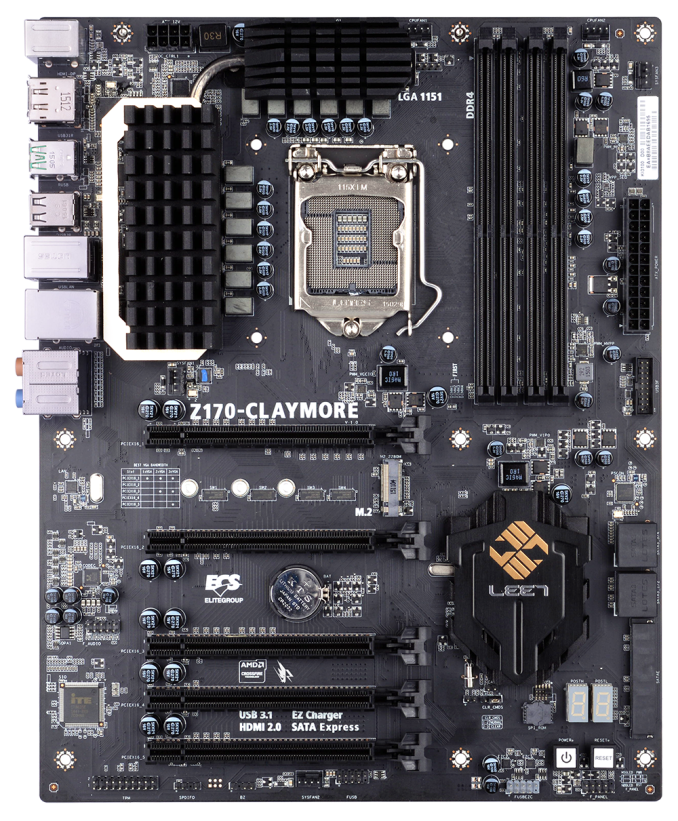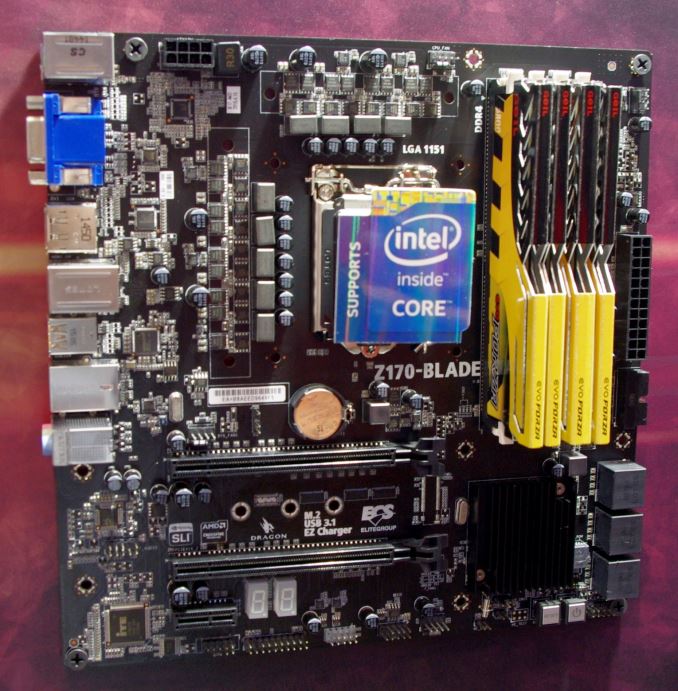Intel Skylake Z170 Motherboards: A Quick Look at 55+ New Products
by Ian Cutress on August 5, 2015 7:59 AM ESTECS Z170
Despite rumors of ECS leaving the motherboard market first being widespread, refuted and then that refutation ignored, we are in constant contact with the team at ECS USA and they were more than happy to discuss a few of their upcoming motherboards for the Z170 chipset. ECS’ fortunes in the consumer motherboard market is actually to the tune of several million a year, but above the base cheap designs in Asia there has been not so much of a push into North America or Europe. For the couple of years ECS has been introducing its’ L33T (‘leet’) brand for gaming, although the nuance might be wearing a bit thin for some as the naming might not necessarily gel with anyone over 14. Nonetheless, the ECS Z170 motherboards came to our attention at Computex due to their use of the new Realtek Dragon 8118AS network controller which aims to compete in the same space as the Rivet Network’s Killer offering for gaming and network traffic prioritization.
ECS Z170 Claymore
At the front is the ATX offering, called the Claymore. Unfortunately not in Scots colors, but the general black theme I am told is so that the Claymore can integrate more easily into many different builds. Aside from the Realtek Dragon 8118AS network controller, ECS goes all out with the PCIe slots offering a combination of x8/x4/x4 from the CPU as well as a couple of others from the chipset – these are mostly likely x1 or x4, or may share bandwidth.
In the middle of the PCIe slots is an M.2 port, although for some reason this only supports M.2 in PCIe 2.0 x2 mode for PCIe based storage. Given how many lanes are available on the Z170 chipset, it makes me wonder why it is not using a full PCIe 3.0 x4. Nevertheless we also get six SATA ports with two bundled with a SATA Express port. Audio comes from the Realtek ALC1150, and USB 3.1-A ports on the rear panel are from an ASMedia ASM1142 controller.
Perhaps surprising here, but ECS is listing the Claymore as supporting HDMI 2.0. This means, because there isn’t an Alpine Ridge controller onboard, that they are using an LS-Pcon in order to do so and are the only ones who are doing it as far as I can tell. I am doubly confirming as this is being written.
ECS Z170-Blade
Despite seeing the Blade at Computex, ECS is not too ready to give details on how the board will look when launched because it is still begin decided. Nonetheless, a good micro-ATX motherboard is always respected, and the Blade will also carry the Dragon Ethernet part alongside USB 3.1.
ECS Z170IU-C43 – Image from 4gamer.net
For the low end of the market, ECS is providing the Z170IU-C43 – a mini-ITX motherboard with a somewhat odd design arrangement. Here the 24-pin ATX connector is at the edge of the board, but due to the CPU and chipset arrangement the 8-pin CPU connector is in no-mans land to the bottom left of the socket. This means that with a GPU in play this connector is very hard to get to and means that cables will be all over the chassis. It’s a design point that all the motherboard manufacturers have had to contend with at some point.
ECS is stating again that we have HDMI 2.0 connectivity on this board, while other functions include the Intel I219-V based networking, the Realtek ALC892 codec for audio, two USB 3.1-A ports on the rear panel and a single PCIe 3.0 x16 slot.














85 Comments
View All Comments
utmode - Wednesday, August 5, 2015 - link
Why so many sata express in so many motherboard?Dahak - Wednesday, August 5, 2015 - link
Yeah, I dont get that either, it does not seem like anyone is doing sata express drives, when NVMe is about to come out. Although its only wasting board space as the SateExpress port can double as 2xSATA ports. I was kinda hoping they would have dropped it for this. Maybe on the other chipsets?Kristian Vättö - Wednesday, August 5, 2015 - link
I think the reason lies in the marketing departments wanting to tick a box in the marketing materials. When one manufacturer includes it, everyone follows the suit so their products won't look "inferior" compared to competitors'. It's no secret that SATA Express is practically dead (although I would say it's a miscarriage), but to those with less technical knowledge it may sound cool and better than regular SATA, even though they will end up using SATAe as regular SATA.Ian Cutress - Wednesday, August 5, 2015 - link
ASRock have their USB 3.1 front panel which uses SATA Express, so there's finally some use for it.silenceisgolden - Wednesday, August 5, 2015 - link
It would work better for marketing departments if they market that they "did not bother with the useless standard, SATA Express".DanNeely - Wednesday, August 5, 2015 - link
The design cycle for these boards probably started a good year ago. By the time it became clear that Sata-Express was a dead standard it was too late to make any major design changes for the initial wave of boards.Slash3 - Sunday, August 9, 2015 - link
As someone with 10 SATA devices, I very much appreciate I/O overkill. :)phorgan1 - Monday, December 21, 2015 - link
You can get more sata in less lanes. Once you use up lanes for nvme drives and graphics cards, the smaller groupings won't support more cards or nvme drives (cards need x8 or x16 and nvme drives need x4) the left overs will support usb and sata. Since sata is such lower bandwidth you can still fit a lot of sata in around the fringes, so why not? A sata ssd is still pretty fast.prophet001 - Wednesday, August 5, 2015 - link
Why no slot for M.2 drives?prophet001 - Wednesday, August 5, 2015 - link
Nevermind. Hadn't fully read the article.